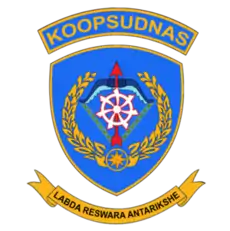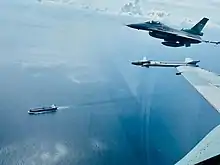Indonesian National Air Operations Command
The Indonesian National Air Operations Command (Indonesian: Komando Operasi Udara Nasional / Koopsudnas) is one of the Principal Operational Commands of the Indonesian Air Force that is responsible for air operations including air surveillance, early warning system and air defense of Indonesian airspace. Koopsudnas plays a vital part for air defense capability of the Republic of Indonesia.
| National Air Operations Command | |
|---|---|
| Komando Operasi Udara Nasional | |
 Insignia of Koopsudnas | |
| Active | 31 January 2022 (as Koopsudnas) 9 February 1962 – 31 January 2022 (as Kohanudnas) |
| Country | |
| Type | Air Defense Command |
| Role | |
| Part of | |
| Motto(s) | Labda Reswara Antarikshe |
| Commanders | |
| Current commander | Air Marshall Andyawan Martono Putra |
| Notable commanders | |
History
History of National Air Defense Forces Command
At the early of 1962, Operation Trikora was getting underway as the Indonesian National Armed Forces (TNI) were already engaging the military forces of The Netherlands in what is now Papua and West Papua provinces. The National Air Defense Forces Command was established on 9 February 1962 as the air defense division of that operation commanded by AVM H.M.Sujono on the basis of the TNI Joint Service Air Defense Command (Komando Pertahanan Udara Gabungan APRI) whose commander for Papuan air force operations was Colonel Leo Wattimena of the Air Force. At the beginning, the INADF was organized into 2 Air defense sectors covering parts of the Moluccas and the then Netherlands New Guinea, each composed of a number of radar stations. By March 1962, four Air Defense Sectors were active nationwide.[1]
After the conclusion of Operation Trikora, the command was the first to be equipped with surface to air missiles in Southeast Asia, with the arrival of the S-75 Dvina SAM system, which served alongside the AZP S-60, M1939 61-K, M1939 52-K, Zastava M55, Bofors 40 mm gun and the Oerlikon GDF until the early 1970s, alongside radar stations built with Warsaw Pact and Yugoslav assistance.
The Air Force Air Defense Command, raised on 12 September 1963, form majority of the personnel under the Kohanudnas. Its primary mission is to develop and prepare combat readiness of air defense capabilities of the air force. The Air Defense Command is based at Halim Perdanakusuma Airport and has 4 air defense wings, which are 100th Missile Defense Wing, 200th Radar Wing, 300th Interceptor Wing, and 400th Radar Wing.[1] Aside from these, personnel of the Army Air Defense Artillery Corps and the Directorate of Air Defense Operations of the Navy, both of the Indonesian Army and Indonesian Navy, respectively and activated in 1962, are under its operational supervision.
History of Air Force Operations Commands
Air Force Operations Command were established 1951 with Air Cdre Ruslan Danurusamsi as its first commander.[2] In 1976, the Command was renamed into Combined Air Combat Command. In 1985, as part of a major reorganization of the armed forces, the Command was split into Air Force Operations Commands 1 and 2 to oversee supervision over all regional air bases and air force formations within Indonesia on the basis of the Air Regions. On 11 May 2018, Air Force Operations Command 3 was officially formed on the basis of the Air Force Operations Command 2 bases in eastern Indonesia.[3]
History of Air Operations Command
In January 2022, National Air Defense Command and Air Force Operations Command 1, 2, and 3 were officially merged into one organization - Koopsudnas. The unified service serves as a umbrella institution managing air defense and superiority operations under the Air Force.[4]
Organization
- Command HQ
- Air Operations Commands (Komando Operasi Udara)
- Air Operations Command 1
- Air Operations Command 2
- Air Operations Command 3
- Air Operations Training Command (Pusdiklatkoopsudnas) - HQ in Surabaya, East Java
| Type A | Halim Perdanakusuma Air Base, Jakarta
|
Sultan Hasanuddin Air Base, Makassar
Air Wing 5:
|
Manuhua Air Base, Biak
|
Atang Senjaya Air Base, Bogor
|
Iswahyudi Air Base, Madiun
|
Silas Papare Air Base, Jayapura | |
Roesmin Nurjadin Air Base, Pekanbaru
|
Abdul Rachman Saleh Air Base, Malang
Air Wing 2:
|
El Tari Air Base, Kupang | |
| Supadio Air Base, Pontianak
|
I Gusti Ngurah Rai Air Base, Denpasar | ||
| Suyadarma Air Base, Subang
|
|||
| Type B | Sultan Iskandar Muda Air Base, Banda Aceh | Dhomber Air Base, Balikpapan | Johannes Abraham Dimara Air Base, Merauke |
| Soewondo Air Base, Medan | Sam Ratulangi Air Base, Manado | Pattimura Air Base, Ambon | |
Husein Sastranegara Air Base, Bandung
|
Muhammad Zainuddin Abdul Madjid Air Base, Mataram | ||
| Sutan Sjahrir Air Base, Padang | Anang Busra Air Base, Tarakan | ||
| Sri Mulyono Herlambang Air Base, Palembang | Syamsuddin Noor Air Base, Banjarmasin | ||
Raden Sadjad Air Base, Natuna
|
|||
| Maimun Saleh Air Base, Sabang | |||
| Raja Haji Fisabilillah Air Base, Tanjungpinang | |||
| Type C | Hang Nadim Air Base,[8] Batam | Iskandar Air Base, Pangkalan Bun | Leo Wattimena Air Base, Morotai |
| Pangeran M. Bunyamin Air Base, Lampung | Haluoleo Air Base, Kendari | Dumatubin Air Base, Tual | |
| Haji Abdullah Sanusi Hanandjoeddin Air Base, Belitung | Yohanis Kapiyau Air Base, Timika | ||
| Wiriadinata Air Base, Tasikmalaya | |||
| Sugiri Sukani Air Base (id), Cirebon | |||
| General Soedirman Air Base, Purbalingga | |||
| Harry Hadisoemantri Air Base (id), Bengkayang |
Notable events
Bawean Incident

In July 2003, Kohanudnas detected unauthorized military aircraft flying over Bawean Island off the eastern coast of Java for more than two hours, and ordered the Indonesian Air Force to scrambled two fully armed F-16s Block 15 OCU from Skadron Udara 3 to intercept the unauthorized aircraft, which were five US Navy F/A-18 Hornets . The incident ended peacefully through a Friend or Foe hand signal. A US spokesman said that the naval aircraft had sought permission to enter Indonesian airspace while escorting a US aircraft carrier, but that the request arrived too late at the Kohanudnas headquarters in Jakarta due to red tape.[9]
Pakistan International Airlines Incident
Pakistan International Airlines's Boeing 737-300 was detected entering Indonesian airspace without diplomatic clearance on 7 March 2011. Kohanudnas then ordered the Air Force to scramble a pair of Sukhoi to intercept and force the aircraft to land at Hasanuddin airport.[10]
Papua New Guinea Aircraft Incident
On 29 November 2011, Syamsudin Noor Airport's radar detected Dassault Falcon 900 EX that carried Papua New Guinean Deputy Prime Minister H.O.N. Belden Namah entering Indonesian airspace, then the airport's ATC and Kohanudnas tries to contact the aircraft as it is an unscheduled flight, but no response. As Kohanudnas also didn't authorize aircraft flight clearance, they decide to scramble two Sukhoi fighter to intercept and shadowing the Falcon near Banjarmasin, South Kalimantan, for about 37 minutes. It was found that Falcon was applied for flight clearance shortly before take-off and the clearance was not granted yet during the incident. The minister of foreign affairs of Indonesia said that Kohanudnas was conducting an electronic identification with radar and a visual identification by intercepting (the aircraft) according to standard procedures, and no harm occurred.[11]
Gallery
 Insignia of Kohanudnas (National Air Defense Command) (xxxx-January 2022)
Insignia of Kohanudnas (National Air Defense Command) (xxxx-January 2022)
References
- "Sejarah Terbentuknya KOHANUDNAS". www.kohanudnas.mil.id. 1 September 2014. Retrieved 14 March 2018.
{{cite web}}: CS1 maint: url-status (link) - "Pengumuman KASAU No. 57/23/Peng/KS/51". Chief of Staff of the Air Force Order No. 57/23/Peng/KS/51 of 1951 (in Indonesian).
- @_TNIAU (2018-05-12). "Organisasi baru TNI AU setingkat Kotamaops yakni Koopsau III telah resmi berdiri, diresmikan oleh Panglima TNI Marsekal TNI Hadi Tjahjanto, S.I.P., bersamaan dengan Kotama TNI AD dan Kotama TNI AL, dalam sebuah upacara militer di Sorong Papua Barat, Jumat (11/5)" (Tweet) (in Indonesian) – via Twitter.
- Noviansyah, Wildan (2022-01-28). "KSAU Ganti Nama Kohanudnas Jadi Koopsudnas". Detik.com. Retrieved 2022-01-31.
- "Koopsau 1". TNI AU. Retrieved 12 March 2020.
- "Koopsau 2". TNI AU. Retrieved 12 March 2020.
- "Koopsau 3". TNI AU. Retrieved 12 March 2020.
- Rahmat, Ridzwan (10 July 2019). "Indonesia inaugurates new airbase on Batam Island". Jane's Defence Weekly. Singapore. Retrieved 12 March 2020.
- "Indonesia scrambles F-16s to intercept US planes". F-16.net. 4 July 2003. Retrieved 25 November 2011.
- "Pesawat Pakistan Disergap 2 Sukhoi TNI". kompas.com. 7 March 2011. Retrieved 14 March 2018.
- "Two Sukhois Tail Papua New Guinean Official Jets". tempo.co. 9 January 2012. Retrieved 14 March 2018.